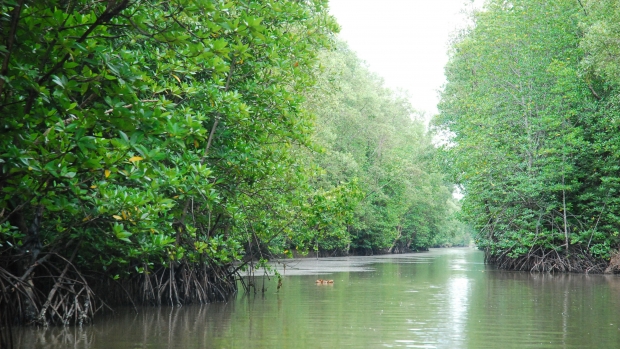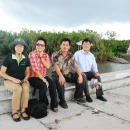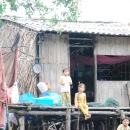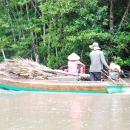Grants :: Small Grant Facilities :: Capacity building in management and conservation of mangroves ecosystem in a community participatory approach in Mui Ca Mau National Park
Capacity building in management and conservation of mangroves ecosystem in a community participatory approach in Mui Ca Mau National Park

Mangroves in Mui Ca Mau National Park, Dat Mui Commune, Ngoc Hien District, Ca Mau Province © MFF Vietnam, 2012
Objectives
The project aimed to sustainably manage the mangrove ecosystem at Mui Ca Mau National Park by enhancing the capacity of local authority and the management board of the Park in attracting the community’s participation in mangroves management and conservation.
Background
Located on the southern tip of Viet Nam, between the East Sea and the Gulf of Thailand, Mui Ca Mau National Park (MCMNP) is a Ramsar site and encompasses over 15,000 ha of mangroves and is recognized as one of the most important wetlands in Vietnam. It is home of many rare and valuable species, some of which are endangered and listed in IUCN's global and national Red Lists. However, there are difficulties and challenges in mangrove conservation and protection.
Before the park was established in 2003, thousands of poor households lived in the core zone where they remain today. Of the four communes inside the park, Dat Mui Commune had the highest number of households, 3,900, living in the core zone. Of these, only 200 households were allocated land. The remaining 3,700 households either had no land, or only enough for housing, because there was no more land to allocate. 819 households had less than 0.5 hectare. Since they could not farm shrimp, and fishing was only possible from June-July when fish are plentiful, thousands of households depended on cutting mangroves and producing charcoal for a living. They ran small kilns that earned households VND3,000,000 (US$150) per month.
The large area and intertwined river system made patrolling and enforcement of regulations difficult. In such a situation, sustainable management of mangroves was beyond the capacity of the MCMNP management board if they did not bring the local community on board. However, the management board of the park lacked the skills in engaging the community to participate in mangrove management and conservation.
Target beneficiaries
- 3,900 households living in the core zone of Mui Ca Mau National Park
Outputs
- Provision of trainings for the national park staff on skills to work with local communities and formulate a management plan in a participatory manner.
- Organisation of various communication activities to raise awareness about the role of mangrove protection: leaflets, information board, broadcasts on local speakers, integrate talks into regular meetings of Women Association, Veteran Association, and Youth Union.
- Creation of 5 community-based forest protection groups, to actively communicate with local households to close down the charcoal kilns that are driving the mangrove cutting.
- Formulation of a mangrove management plan with community participation, including benefit-sharing mechanism in sustainable use of mangrove resources.
Accomplishments and challenges
- As a result of the active engagement of 5 forest protection groups, the number of charcoal kilns was reduced by 30% within 6 months. Taking into account the fact that many of these kilns were quickly rebuilt because the households lacked another economic alternative, the park worked with the CPC to provide low interest loans from the Viet Nam Bank for Social Policy to charcoal makers to invest in new livelihoods.
- Twenty trained staff from the park actively participated in formulating a participatory management plan for the park, which was integrated in the park's annual budget for implementation. The management plan emphasized a benefit sharing mechanism, seeking chances to diversify livelihoods for local households such as community tourism, sustainable fishing, cultivation, souvenir production (linked with MG) so as to reduce the pressure of mangrove cutting as well as to create economic incentives for mangrove conservation.
Contributions to cross-cutting themes
- Communications
- Gender equality
Lessons Learned
- Participation of the local community to join the park's conservation efforts proved to be an effective tool for the enforcement of regulations on mangrove protection . The community's awareness increased and they became active communicators of the value of mangrove conservation.
- The traditional top-down management distanced local people from governmental agencies. The partnership established between the park and community-based forest protection groups filled this gap and helped the park to create synergies and work with a participatory approach. This modality should be replicated in many other protected areas where the surrounding households depend on natural resources for their subsistence.
- To sustain the project results, the park together with local authorities should take a holistic approach so as to harmonize the needs for conservation and livelihoods transition in the local community. The 'do no harm' principle should be applied, aiming to minimize the damage done to local households by stopping them from cutting mangroves.
Project Facts
Country
Location
Mui Ca Mau is a national park in southern Vietnam. It is located in Dat Mui Commune, Ngoc Hien District, Ca Mau Province, the southernmost of Vietnam's provinces
Topic
- Civil Society Engagement
- Capacity Building
- Community Resilence
- Knowledge management and communications
- Gender equality
Duration
1st Nov 2012 to 30th Jun 2013
MFF Grant Amount
VND294,020,000
Implementing Partner
Mr. Luu Ngoc Hieu (Project Coordinator)
Mui Ca Mau National Park
Address: Rach Tau Dong Hamlet, Dat Mui Commune, Ngoc Hien District, Ca Mau Province
Tel/Fax: 84-780-3824625
Email: vqg_mcm@yahoo.com.vn



